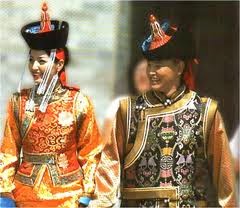Mongolian Wedding Ceremony.
The traditional Mongolian wedding ceremony has slowly changed
over time. Still the Mongolian people are trying to keep the traditional
wedding rituals while also caring about the younger generations’ interests by mixing
modern wedding notions with traditional ones.
Most Mongolian people care about the in-law’s family roots.
Mongolian people say that the future son-in-law’s father should accept their
daughter and the future daughter-in-law’s mother should accept their son. This saying means that the son-in-law will treat
his future wife like how his father treated his wife, and that the daughter-in-law
will treat her future husband like her mother treated her husband.
Mongolian Engagement
When the Mongolian couple agrees to marry one another and
they then explain their engagements to the groom’s parents. The groom’s parent
wishes good luck for their son’s future life and plans the ceremony with the
bride’s parents’ to discuss the proposal. At the engagement ceremony the
groom’s father brings a hadag – (a specially made band of silk) and a silver
bowl-like cup filled with milk, this means that he welcomes his daughter-in-law.
He says that the couple loves each other and we love your daughter, your
daughter will marry my son, we will treat your daughter like our own daughter
and he then gives the hadag and silver bowl-like cup with milk to the bride’s
father. If the brides’ father accepts the bowl-like cup then the bride’s
parents’ will later on start to plan an engagement ceremony.
When the bride’s family accepts the engagement, it means
they accept the groom as their own son.
Mongolian
wedding ring symbols
The groom’s wedding ring has two crowns that intersect with
one another, this resembles the souls of both the bride and groom being
conjoined together forever in true love. His ring shape is round like the
Mongolian ger (yurt) which has a round crown, this is called a toono. This
means the husband resembles the house roof that will act as protection of his
wife and family. Her ring crown is in the shape of a diamond, also similar to
the shape of the Mongolian ger (yurt) bagana and this is supposed to represent
the post that holds up the ger. This means the wife is the center support of
the family, like holding up a roof. On each ring there’s four connected dots on
the outside of the crown shape. The two crown shapes that are crossing and
interconnected means the couple will be together forever in soul and life.
Also 4 dots each together look up from every quarter in the
world and together through anything and forever.
The wife wears her wedding ring on the left hand wedding
ring finger, this means that she carries her husband in her heart. The husband wears
his wedding ring on the right hand ring finger, this means he carries the
strength of their life together.
Mongolian wedding ceremony.
Each Mongolian aimag (state) has customs that are a little
different when it comes to Mongolian wedding ceremonies. The bride and groom
choose their wedding witnesses, they traditionally choose a sister-in-law. In
Mongolian families the daughter in law is like their own daughter so sister in
laws are the same as sisters.
At the wedding ceremony Mongolian people wear long sleeved
clothing that cover their shoulders; the long sleeves and covered shoulders
represent a good and complete life for the couple.
The Mongolian Wedding Palace is where most people celebrate
their wedding. The Bride and groom stand arm in arm, with them they will have
two witnesses (who are usually the sister-in-laws) standing in front of the
official. The official will ask the couple if they will marry one another. The
bride and groom will answer “Yes”, after that they will sign their wedding
documents and the wedding official will have witnessed that they signed the
document as well. They place the rings on after the wedding official pronounces
them husband and wife.
Mongolian wedding gifts
The gifts received are very important for the newly weds and
their start of a new life. The gifts of the newlywed’s parents help aid their
future life. The husband’s family gives a ger (yurt) and some animals. The wife’s
family gives a full kitchen set, they also give clothes and jewelry. These gifts allow them to have a roof and a
beginning to life.
Friends and relatives usually give money or other gifts.
In modern times the parent’s gifts are different but most herders
still give a ger and animals.
Mongolian wedding
reception.
The arrangement of the wedding reception is like a Mongolian
ger (yurt) in a side style way, the door always faces south. The groom stands
north west, next to him is a honord sister – in – law, and so are his father
and mother, around them are his relatives and friends; the wife stands to the
husband’s left, next to her is a honored sister-in-law, and so are her father and
mothers, around them are her relatives and friends. The eldest of the group
tend to sit in the front of the ceremony as a sign of respect.
A Mongolian wedding consists of singing traditional folk
songs; also the newlywed’s receive blessings and good wishes.
By. S. Uzmee 10.28.2014


















